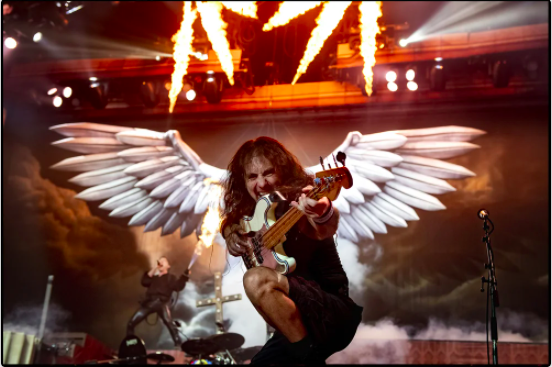Words by Simon Edwards
I didn’t love music before Iron Maiden. I listened to music, but I had no favourite songs, no favourite albums, no favourite bands – it wasn’t a part of life that I really cared much about, even though I’d played piano since childhood. I think this is the case for many people, with the same eventual outcome; one day a band enters your life and strikes you deep, in a part of you that you didn’t think music could even reach, and chances are that even as your tastes evolve, they’ll never let you go.
For me, that moment was when my godfather, living up to the expectations of his sacred position, decided that it was his duty to save my soul from the clutches of Slipknot, and the nu-metal devils surrounding it. Passing me his headphones across the dinner table with a cheery “give this one a go”, he started up Flight 666, Maiden’s 2009 live album from their Somewhere Back In Time World Tour. I believe wholeheartedly that there is no finer introduction to the band: the audio-peaking roar of the Mumbai crowd, the scene-setting audiotape leading into the opening bars of Aces High, and the ensuing five minutes of melodic furore and soaring vocals will give anyone who listens a definitive, tone-setting taste of what Iron Maiden is all about. The band’s distinctive sound stands out in every note – frenetic drumming, dual guitar solos, Steve Harris’ galloping basslines and the unbelievable pipes on frontman Bruce Dickinson, creating a sound that is often imitated, but never replicated or matched. I sat completely still through the whole song, trying to take in every note, and finally took out the earphones and looked at my godfather, genuinely shaken (pretentious even then, it’s a curse) but convinced that music could not get any better than that. I still stand by that belief.
Maiden’s versatile but distinct sound is one of the band’s greatest strengths – evocative, punchy, but eminently listenable even for a non-metal fan, the band has retained a clear-cut musical identity that has sustained and evolved for over forty years, through sixteen studio albums, the addition of a third guitarist, experimentations with form and genre, and more besides. Listening to a track from 1981’s Killers and 2015’s The Book Of Souls, you would note the vast changes in tone, style, pace and structure, but both songs would clearly be built on the same foundation. This robust sense of self-assurance and identity is the core of Maiden’s longevity, and why I love them so much – they are, to a fault, true to themselves, and their artistic vision.
This belief in the self can lead the Maiden boys into frustrating avenues – overlong songs, eye-melting live videos and the truly appalling cover-art for 2003’s Dance Of Death (look it up) among them – but authentic, genuine artistic vision of the sort that has sustained the band since its inception has contributed to its finest moments: a whole album, forged in the horrors of the War on Terror, which serves a scathing anti-war polemic that rejects hate and embraces compassion; world tours which aim to visit every Maiden fan across the globe, from Santiago to Shanghai, and ensure their passion is properly rewarded; songs that sound ridiculous conceptually, like a fourteen-minute epic based on Coleridge’s Rime Of The Ancient Mariner, that not only works but is, in my opinion, the greatest song ever recorded, by anyone, ever. These highs, the band’s greatest achievements, are the result of an unwavering determination to deliver music the band believes in, that sounds like Iron Maiden, to anyone who cares to hear it.
And plenty do care to. An Iron Maiden concert is something special, and worth experiencing if you’re able. For one thing the band deliver the kind of live performances that would shame bands a third of their ages – the energy on stage is palpable, of a kind only a band who still loves their art four decades in could generate. But at the same time, they are a celebration of the band, and the people who have loved it, for however long they have, as passionately as Maiden fans do. A Maiden crowd is a kaleidoscopic group, all wearing some form of tour shirt or another, probably from gigs that might’ve happened before the younger attendees were born. It’s dedicated too – there’s plenty of mockery thrown the way of Maiden fans for their excessive love of the band, but it speaks to the close-knit relationship between the fans and the music (or how successfully the band markets that relationship, if you’re a cynic).
This passion reflects Maiden’s unique place in music: no radio play, little recognition in mainstream music media, but sell-out tours across five decades and near chart-topping albums every time another releases. The band’s longevity, success and ability to make music that they believe in is rooted in the security of a loyal fanbase who believe in that music too. Maiden fans cross age-groups, national borders, and embrace anyone who loves the band (besides the gatekeepers, best beaten back with a stern rebuke and a big stick), and as Rich Cooper wrote in a 2017 review of their Book Of Souls live tour, “Iron Maiden sustain their fans, and the fans sustain Iron Maiden”.
That sustaining relationship between band and audience might be the reason I went back to them over the last year or two, across both the occasional homesickness of a year abroad in the States and the suffocating isolation of the pandemic. Falling back into the Maiden world again set my mind back to that moment at my dining table, or the first time the strains of Doctor, Doctor by UFO faded away and my first concert experience began. These are moments that solidified my love not only of Maiden, but the power of music itself, and the unifying strength it carries. It’s a feeling I look forward to experiencing again, either at Download next year or (hopefully) sooner – the greatest band to ever play, still at the top of their game after all this time, should be treasured.





